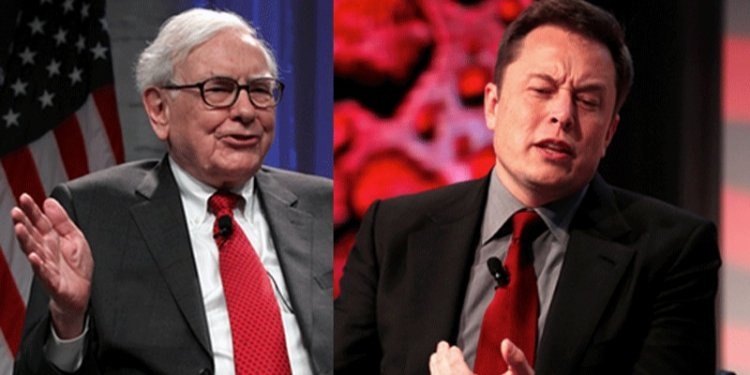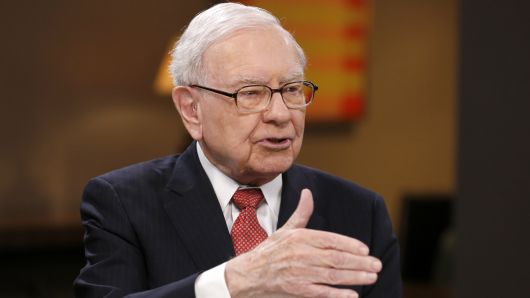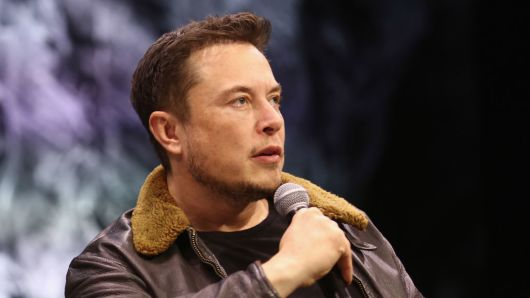Elon Musk Innovation vs Warren Buffett Competitive Advantage
 Image credit: Inc.
Image credit: Inc.
Warren Buffett and Elon Musk.
One is an old-school investor who prizes valuable brands and invests only in businesses that he understands really well.
The other is a futurist behind some of the most innovative and well-known tech companies in the world.
They are both one of the richest men in the world but the former uses a risk-averse investment philosophy while the other has a high tolerance for risk.
One is an oracle and the other a visionary. Warren Buffett, the CEO of Berkshire Hathaway and Elon Musk, the CEO of Tesla.

Image credit: Business Insider
The difference runs deeper. They both have different philosophies on what is most attractive about a company and an investment.
Buffet prizes “moats” while Musk prizes innovation.
Buffett vs. Musk—Moats vs. Innovation
Buffett coined the term “moats” in a 1999 Fortune article.
Buffett describes his strategy as looking for “economic castles protected by unbreachable moats.”
Indeed, the entrepreneur and investor has always said that the companies he buys have a sustainable competitive advantage, i.e. a moat.
Simply put, a “moat” is a competitive advantage.
To understand it better, here is what Buffett notably said at Berkshire Hathaway’s 2000 annual meeting:
“So we think in terms of that moat and the ability to keep its width and its impossibility of being crossed as the primary criterion of a great business.
And we tell our managers we want the moat widened every year. That doesn't necessarily mean the profit will be more this year than it was last year because it won't be sometimes.
However, if the moat is widened every year, the business will do very well. When we see a moat that's tenuous in any way -- it's just too risky. We don't know how to evaluate that. And, therefore, we leave it alone.
We think that all of our businesses -- or virtually all of our businesses -- have pretty darned good moats.”

Image credit: CNBC
Moats come in many forms: from patents to brand recognition to secret formulas to distribution models.
A good example of a moat for a company is switching costs—something that the telecommunications industry exemplified and took advantage of.
In making customers pay to switch or cancel a contract, telecommunications companies put up barriers for their customers to leave. The costs also make it more difficult for competitors to undercut them.
Another example of a moat is information. That’s a situation where you have so much customer data in your system that customers find it hard to switch from your service even if a competitor is offering a lower price.
Think of an email marketing company like Constant Contact. They have so much customer data that a company would have to export their entire database and content if they want to switch to another provider. That makes it more daunting for their customers to consider switching.
So when you’re thinking of a long-term vision for your business, you need to spend time building your moats and the rest of your outcomes will fall into place. That’s according to Buffett and other successful business people and investors.
On the other hand, Musk strongly believes in innovation as the key ingredient of an attractive investment.
More precisely, Musk believes in “dynamic capabilities.”
Dynamic capabilities were a common focus within strategy in the 1990s. The idea of dynamic capabilities is that a company’s capabilities, not just its assets, can create a sustainable advantage.
That seems to be Musk’s view of strategy—that Tesla’s advantage comes from its capability to innovate as opposed to its assets or niche in the automotive market.
That is evident in his decision to open up some of Tesla’s patents.
So, according to Musk, capabilities, not assets, are a company’s competitive advantage.
Buffett and Musk’s disagreement over the two seemingly different philosophies played out in a public forum. Here’s how it went.
It started off when, in a conference call, Musk said, “moats are lame.”
According to Musk, "They are like nice in a sort of quaint, vestigial way. If your only defense against invading armies is a moat, you will not last long. What matters is the pace of innovation — that is the fundamental determinant of competitiveness.”
Buffett responded, “There are pretty good moats around.”
At the recent Berkshire Hathaway shareholder meeting, Buffett added, “Elon may turn things upside down in some areas. I don’t think he’d want to take us on in candy.”
When Buffett referenced See’s Candies, his confectionery maker, as proof of his concept, Musk pledged to create his own candy maker.
I’m starting a candy company & it’s going to be amazing
— Elon Musk (@elonmusk) May 5, 2018
So, who do you side with?
Both May Be Right
Warren Buffett has been successful largely due to his purchases of undervalued companies while Elon Musk has achieved success by marketing an overpriced company so it becomes even more overpriced.
Buffett’s approach is old-fashioned and relies on reliable businesses and their traits that have endured the test of time. Musk’s approach values disruption and the potential for rapid expansion in coming years.
Both approaches are important. But if Buffett’s approach were a tad bit more extreme and controlling, there would have been no progress. And similarly, if Musk’s were a bit more extreme and dominant, everything would just be PR and bubbles.
To better understand their debate, it helps to ask CEOs about their visions for their companies.
What CEOs Think About Moats vs. Innovation
When you ask many CEOs about their vision for their company, they usually give you an answer that is informed by metrics like market share and profitability.
While those metrics are critical to the success of any business, they are simply outcomes of a strong machine or moat.
Your machine is the way your business operates in a predictable way. For example, if you get a certain amount of appointments or leads, you can predict with great accuracy that you will eventually get a specific set percentage of those customers, each representing a certain amount of revenue and profit.
As the CEO of that company, you will then become responsible for pulling different levers on that machine based on how much you want to grow the business, accounting for some degree of diminishing returns in the process.
The ideal business machines also have recurring revenue built into their business models. For example, a subscribed base of customers that pay fees every month or renew their contracts on an annual basis.
Companies that have a high percentage of annual revenue are extremely valuable and attractive to private equity firms because they operate like machines that know what their revenues and profits will be any given year.
So in some instances, your goal as CEO could be to build a better machine. Let’s say your company is really good at acquiring customers but your business model is built on a transaction basis.
You constantly have to work at acquiring new customers. Even though you do a good job at that; if you find a way to build elements of recurring revenue into your machine, you could increase the value of your business exponentially.
That is when moats come in. Great machines are imitated so you have to protect yourself. Moats protect your business from your competitors’ attacks.
If you build a profitable machine in your business, your competitors will attempt to copy that model and steal your customers. A business moat is essentially something that keeps your customers away from your competitors.
It’s a logical business idea that has been around for ages, but was made popular by Warren Buffett.
Moats are Key
Competitive strategy helps an organization to create a niche, dictate how they would like to operate and stay in an industry and gain a competitive advantage over their competitors in the same industry.

Image credit: Harvard Business Review
If a company does not have a competitive strategy, it will be unable to find a steady foothold to maintain a strong competitive advantage to stay in that industry.
In addition, in order to be successful, a company needs to have a competitive strategy that works well with its core business process. They must be able to use the strategy to attract customers, and more importantly, to keep them loyal.
And every organization, big or small, needs a competitive strategy.
If we look at Target, we see theirs clearly: The Best-Cost Provider Strategy. That strategy attracts loyal customers who want to buy good value at competitive prices.
While some other companies like Dollar Tree have a Low-Cost-Provider Strategy to attract certain customers that want very low prices for products.
Companies like Apple and Staples use a Focus strategy where they concentrate all their resources in a particular segments of the market, consumer or industry.
Staples focuses only on office supply products while Apple practices a type of Focus strategy known as Focus Differentiation Strategy that targets high end consumers that are willing to pay more.
A company needs to be consistent and stick to whatever competitive strategy they go with within their industry because it will always need to weather the storm of competition to stay in the industry.
But innovation is necessary for survival as well.
Now, it can be argued that innovation is a component of a moat. Indeed, to remain competitive, you have to innovate.
Companies like Google and Facebook exemplify that argument. Both Google and Facebook innovated early but didn’t innovate as well in their later stages. They instead bought out companies that innovated.
Google bought YouTube and Facebook bought Instagram. Both made those companies better and turned them into behemoths.
And innovation does not have to be a massive leap, like Musk thinks. Innovation could be incremental.
But more on Musk’s argument.

Image credit: CNBC
Innovation is Key
Two-thirds of respondents in a Deloitte Innovation Survey 2015 said that innovation is important for growth. Businesses that focus on innovation are able to scale up and employ more people. That in turn allows them to build their customer base and grab a bigger share of the market.
Innovation also makes it easier to grow, regardless of the size of your business. It enables Fortune 500 companies and startups alike to grow.
It also enables you to stand out from competitors and actually build that moat that Buffett touts. Your company is in a specific industry or niche, but the problem is that it is not alone. Other companies are also doing the same thing. One of the ways you can stand out is through innovation.
The right innovation will enable you to offer your customers something unique. Top innovators take mainstream products and make them even better. That’s how brands stand out in the market and increase their revenue.
Also consider that customer needs change constantly. Your customers may need exactly what you’re offering right now, but may need something else tomorrow. Innovators predict market changes and provide solutions before people even realize they need them.
Indeed, you cannot meet your customer’s needs long term if you’re unwilling to innovate. If you remain in one spot, so will your business—it may even slide back. You constantly have to come up with new ideas that excite your customers and meet their needs.
Furthermore, talented and innovative people, especially millennials, want to work for innovative companies. You’re not going to attract someone who will create the next best thing unless your company has a history of creating and innovating.
Overall, innovation is vital in the workplace because it gives companies an edge in penetrating markets faster and provides a better connection to burgeoning markets, which can lead to bigger opportunities.
Those are Musk’s basic arguments on the importance of innovation in opposition to Moats. Do you however think both misunderstand the other?
Moats are important. So is innovation. But it can be argued, as above, that innovation is part of competitive strategy.
Not to belabor the point, here’s a clearer explanation:
Competitive advantages emerge when companies and its people do great work. Coca-Cola has a competitive advantage because of its secret formula which is loved by millions of customers worldwide. Apple has a competitive advantage because it created products that millions of people love and use daily.
Tesla also has a competitive advantage in that it built an electric vehicle that people actually enjoy driving.
And it has to be made clear that Buffett never said that companies should rely solely on their competitive advantages. And Musk’s suggestion that Buffett suggested that misses the mark. Apple innovates. So does Coca-Cola. The car industry is also innovating as it moves to autonomous vehicles.
Perhaps the argument is not really about moats versus innovation. Perhaps it is about their different management and investment styles.
Buffett looks at Tesla as the epitome of a horrible investment. Buffett values companies that have healthy management incentives, simple operations and little competition. Tesla has none of those qualities.
If we look at management incentives, Musk is paid for increasing Tesla’s share price. He has a new 10-year bonus plan that could see him earning $55.8 billion in stock if Tesla’s market cap hits $650 billion and certain revenue and profitability targets.
If he misses those goals, well, he has other ventures in the pipeline. He has a significant stake in the rocket company SpaceX which has been recently valued at $26 billion.
Wrapping Up
Buffett and Musk’s debate is more intricate than the scope of this article for corporate leaders who focus on more of a strategic approach.
Their jabs at one another highlight their leadership styles. Musk is focused on innovation as that is what he founded his companies on. He can miss quarterly earnings and still be OK with that.
But a traditional CEO, like Buffet, who has to hit their quarterly earnings targets needs to adopt the moat strategy.
Both strategies have their virtues and both can be successful. In fact, both are needed to sustain the swiftness and productivity the market demands.




